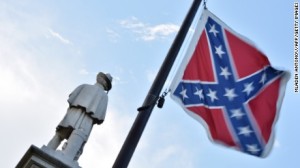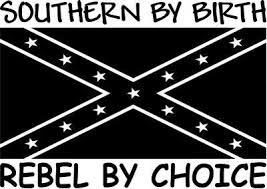The issue of the Confederate flag has caught my eye over the last few days. I’m reminded of one wintery night several years back; we were in Vermont, driving west across the state on a 2 lane road. As we approached a stop sign just beyond Danville, you couldn’t miss it: a big farmhouse with no curtains at the windows, through which any passerby could see a huge Nazi flag covering one wall. It caught me by surprise – and I felt almost fearful that such a thing could exist in this place that always seems so civilized.
So I’ve done some reading about the Confederate flag, which never was the actual flag of the Confederate States of America. The Confederacy adopted 3 other flags during its short history, but none of these was the one we’re most familiar with.
I’ve wondered about the role of the flag in the “good old boy” South – that sort of down home brotherhood that seems to flourish around images of the General Lee, or (remember this?) Dueling Banjos. Today, it’s a popular symbol for rebellion, in one form or another:
Or a fashion statement:
Or maybe, even now, something a little closer to the original debate over states’ rights:
Turns out that the cultural symbolism of the flag we know as the Stars and Bars is much more recent that the War Between the States. Here’s a bit of what I found (excerpted and paraphrased from This Week magazine online, with my own commentary thrown in):
In 1948, Strom Thurmond’s States’ Rights Party adopted the Battle Flag of Northern Virginia as a symbol of defiance against the federal government. What prompted Thurmond’s defiance? President Truman attempted to enforce civil rights laws in the South, and the Democratic Party took a somewhat progressive platform on civil rights. Thurmond, if you don’t know, served in the Senate until age 100. He ran for President in ’48 on the State’s Rights Democratic Party ticket. (Read that again – State’s Rights Democratic Party) – 80 years after the Civil War ended. At the time, South Carolina was a one-party state so Thurmond had to create his own party. Later, he opposed the 1964 Civil Rights Act.
There’s more. Lots more. For example, the emergence of his African-American daughter, Essie Mae Washington Williams, after his death.
You can read up on Thurmond. I suggest that you do.
Georgia adopted its version of the flag design in 1956 to protest the Supreme Court’s ruling against segregated schools, in Brown v. Board of Education. This fact really amazed me – the flag became symbolic of “separate but equal” schools.My husband Mike went to jr. high school in Virginia in the 1960’s – where schools were indeed still separate despite the Brown ruling. He got a good look at inequality when he saw that the Black students on the city bus carried books that had been discarded from the school he attended. (And by the way, he was on a city bus because district transportation was not offered to Blacks….or US Navy dependents regardless of race.)
In 1961, George Wallace raised the flag over the legislature in Alabama, specifically to send a message opposing efforts to integrate the South and to remind Alabamans of the secession of the South exactly 100 years prior. George Wallace was one of the most hateful politicians in my lifetime – probably the most hateful, as I think about it. You may recall one of his more famous remarks, “Segregation now, segregation tomorrow, and segregation forever!” He also threatened to “stand in the schoolhouse door” to prevent Black students from entering White schools. And yes, he wanted to be president too, in 1968. So he used the Confederate flag to symbolize the voice for secession because of integration – 96 years after the Civil War ended.
The following year, the flag went up over the state capitol in South Carolina.
The flag came down in Alabama this week. It’s a little more complicated in South Carolina because legislation is required to remove it.
So is the Confederate flag part of America’s history? Well, the Confederacy is, and they did have flags. But the one we think of carries cultural significance in that it symbolizes…
Opposition to civil rights legislation,
to integration,
to social equality for black people.
It’s not about the “good old boy” south – and if you didn’t know, both of my parents were born and raised well south of the Mason Dixon line. Not about Vietnam or Obama or the damn Yankees or even Paula Deen. (Do we remember Paula? Oh, there might just be a little connect the dots moment happening right there…)
(Post Script: I make no claim that the Confederate flag as an object is responsible for all the the racism or violence in our country. I have deep concern about mental health, about education, and about what happens when guns fall into hands that should not have them. But the continued presence of this flag in the south has always baffled me, just a bit, and I’m glad it’s opening up conversation now.)





My wife and I have deep southern and Appalachian roots. My Granma’s family was old southern tidewater plantation and slave owning-Native Americans… Family broke up over slavery.
The McCoy side was pro Union- as was my wife’s family-including her Native American side.
Never liked that flag. Granma wouldn’t have it or anything to do with the Confederacy in the house. No $20 bills either..